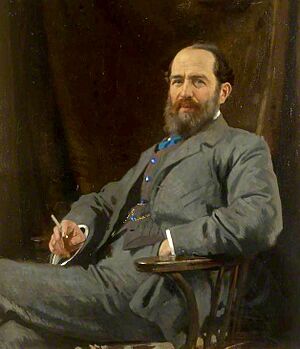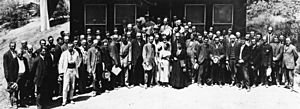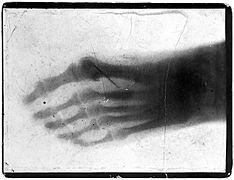Arthur Schuster facts for kids
Quick facts for kids
Arthur Schuster
FRS FRSE
|
|
|---|---|
 |
|
| Born |
Franz Arthur Friedrich Schuster
12 September 1851 |
| Died | 14 October 1934 (aged 83) Yeldall Manor, Berkshire, England
|
| Awards |
|
| Scientific career | |
| Academic advisors | Wilhelm Eduard Weber |
Sir Franz Arthur Friedrich Schuster (12 September 1851 – 14 October 1934) was a famous British physicist. He was born in Germany. A physicist is a scientist who studies how the universe works.
Schuster was known for his work in many areas. These included spectroscopy (studying light), electrochemistry (electricity and chemistry), and optics (how light behaves). He also worked with X-rays and used harmonic analysis to understand physics. A special math idea called Schuster's integral is named after him. He helped make the University of Manchester a top place for studying physics.
Early Years
Arthur Schuster was born in Frankfurt am Main, Germany. His father, Francis Joseph Schuster, was a cotton merchant and banker. His mother was Marie Pfeiffer.
In 1869, Arthur's family moved to Manchester, England. Their family business was there. Arthur joined them in 1870 after studying in Geneva. He and his siblings became British citizens in 1875.
Arthur was interested in science from a young age. After working for his family's business for a year, he convinced his father to let him study. He went to Owens College in Manchester.
He studied math and physics there. He even started doing research on light from hydrogen and nitrogen. He then spent a year studying in Germany and earned his PhD. A PhD is a high university degree.
Schuster later used his family's money to help science. He bought equipment for labs. He also helped fund teaching positions at Manchester and Cambridge universities. He supported the Royal Society and international science groups.
After more studies in Germany, he returned to England. He was chosen to lead a trip to Siam (now Thailand). His job was to photograph the sun's outer layer during a total solar eclipse in 1875. This was a very important job for a young scientist. On his way, he wrote about seeing a "green flash" in the sky.
Career and Later Life

When Schuster came back to Manchester in 1875, he started researching electricity. He then spent five years at the Cavendish Laboratory in Cambridge. He worked with famous scientists like James Clerk Maxwell and Lord Rayleigh.
In 1881, he became a professor at Owens College. He later became the professor of physics in 1888. This allowed him to build a large and active physics department. In 1900, a new laboratory that he designed was opened. It was one of the biggest in the world.
This lab became very famous. Much of its later fame came from Ernest Rutherford. Rutherford took over from Schuster as professor in 1907. Schuster stepped down partly for his health and to help international science. He made sure Rutherford would be his replacement.
Schuster is known for coming up with the idea of antimatter in 1898. He thought there could be "antiatoms" and even whole "antimatter solar systems." He believed that if antimatter met normal matter, they would create energy. Later, in 1928, Paul Dirac gave this idea a math basis. This led to the discovery of antiparticles.
Schuster is also remembered for his periodogram analysis. This is a way to find patterns in data over time. He used it in 1897 to study earthquakes. He also used it to look at sunspot activity. Sunspots are dark spots on the sun. He found that good grape harvests in Europe seemed to happen every eleven years, which is about the same time as the sunspot cycle.
Schuster also helped start the study of how light moves through space. This is called the radiative transfer problem. In 1905, he explained how light lines appear in stars. His ideas are still used today in weather and climate models.
In 1912, he bought a home called Yeldall Manor in Berkshire, England.
During World War I, some people were unfair to the Schuster family because they were of German origin. But Arthur's brother, Sir Felix Schuster, stated that the family was loyal to Britain. All their sons were serving in the British army. Arthur learned his own son was wounded on the day he gave a big speech in 1915.
People at the time saw Schuster as a very smart physicist. He was also a good leader and teacher. He believed science was important for education and industry.
He passed away on 14 October 1934. He is buried in Brookwood Cemetery in London.
Family
In 1887, Arthur Schuster married Caroline Loveday.
Honours and Awards
Schuster became a Fellow of the Royal Society (FRS) in 1879. This is a very high honor for scientists. He was made a knight in 1920 by King George V. This means he was called "Sir Arthur Schuster."
He also received special degrees from universities like Calcutta, Geneva, St Andrews, and Oxford. He won important awards from the Royal Society, including the Royal, Rumford, and Copley medals.
Schuster served as a secretary and vice-president for the Royal Society. He also worked with international science groups. He was involved with the Meteorological Office and the National Physical Laboratory.
The Schuster Laboratory at the University of Manchester is named after him. It is where the School of Physics and Astronomy is located.
Gallery
See also
 In Spanish: Arthur Schuster para niños
In Spanish: Arthur Schuster para niños
- Blackett effect
- Diffuse reflectance spectroscopy
- Electron
- Electron rest mass
- Representative layer theory
- Sharp series
- Space weather





